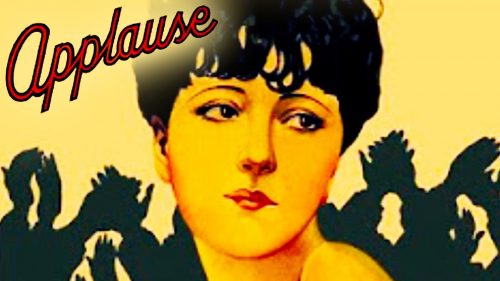A burlesque star seeks to keep her convent-raised daughter away from her low-down life and abusive lover/stage manager.
Filming began on 10 June 1930 at Paramount’s West Coast studio, according to the 15 June 1930 Exhibitors Herald-World. Working titles of the film included Portrait and Every Day Is Sunday. Although some sources listed a running time of 90 min, the print viewed was approximately 80 min, the running time listed in the Var review. Interiors for the film were shot at Paramount’s Astoria Studios on Long Island. Exteriors were shot throughout New York City, including the Brooklyn Bridge, a subway station and the top of a skyscraper.
Applause marked the motion picture debut of Russian-born director Rouben Mamoulian (1897–1987), who had been a successful opera and theatrical director from the time of his arrival in the United States in 1923. Three years after accepting George Eastman’s invitation to direct the George Eastman Theatre in Rochester, Mamoulian went to New York City. In 1927, he directed the Theatre Guild production of Porgy, considered a Broadway milestone. Mamoulian revealed in interviews years after Applause was made, that initially, during the production, he met with considerable opposition from his crew, particularly from cameraman George Folsey.
Reviews noted Mamoulian’s extensive use of a moving camera, which the LAT critic called “a triumph of craft.” The reputation of Mamoulian’s highly stylized and innovative direction, as well as Folsey’s camera work, has increased over the decades. Mamoulian was the first director to utilize two simultaneous sound tracks, and several reviews pointed out the advances Applause made in the development of motion picture sound.
Although Applause did not mark the screen debut of singer Helen Morgan (1900–1941), it did mark her first starring role. Critics praised her performance, noting her transformation from a sultry, dark-haired singer into the frazzle-haired blonde burlesque performer. Although her “Kitty Darling” character is supposed to be too old to perform, in fact, Morgan was only thirty when she appeared in the film, just nine years older than Joan Peers, who portrayed her daughter, “April.” (For additional information about Morgan’s life, please consult the entry for the 1957 biographical film The Helen Morgan Story). Applause also marked the debut of Peers (1909–1975), although some modern sources suggest that she may have appeared in one or two bit roles prior to Applause.
When the picture opened in New York City, various Catholic officials in the United States took exception to a line in the film in which “Kitty” tells “April” that many “Shakers” are “just as good Catholics as others,” saying that they “would be just as well satisfied if the picture makers had attempted to compliment the Methodists.” To remedy this situation, the Hays Office suggested that the word “Catholic” be deleted from the film during the exhibition by instructing theatre owners to “turn down the fader or blur the dialogue at that point.” In the viewed print the word “Catholic” is, in fact, inaudible.
More on Wikipedia
Watch Applause (1930)






